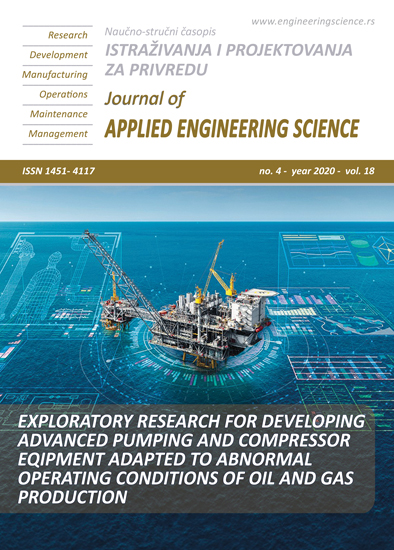DEVELOPMENT OF METHODOLOGICAL FOUNDATIONS FOR THE DESIGN OF LOGGING INFRASTRUCTURE TAKING INTO ACCOUNT THE DYNAMICALLY CHANGING ENVIRONMENT
Abstract
Development of forest resources is currently associated with significant difficulties, primarily due to unsatisfactory infrastructure in greater part of the forest area. It is necessary to create an effective, mathematically based forest infrastructure so that the forest industry will be developing actively. This will create the prerequisites for effective continuous and sustainable use of the forest. At the same time, the transport and economic availability of wood resources will increase significantly. There are many options for organizing the logging process by forestry enterprises. In most cases, they are selected by management based on personal experience. This study is a continuation of the work of the author's team on the complex problem of algorithmization and optimization of logging operations, taking into account the analysis of various moving and processing operations of wood resources. In previous publications, the authors presented a graphic-analytical model for solving the task. This article presents a description of the algorithm developed on the basis of the presented mathematical and graphic-analytical models for finding an effective technological chain of transport, loading and unloading and processing operations of the logging process in dynamic natural production conditions. The developed algorithm can be considered as a methodological basis for logging infrastructure design, taking into account the dynamically changing environment.
References
Chernykh,R. A. (2018). Justification of transport schemes of forest roads for effective development of forests (on the example of enterprises of the Lower Angara region). Ph.D. thesis. Ural State Forest Engineering University.
Tretyakov, A. G. (2015). Assessment of the economic accessibility of forest resources and the processing of low-quality wood. Vestnik Omskogo universiteta [Herald of Omsk University]. Series «Economics»., no.1, pp.142-149.
Tretyakov, A. G. (2015). Economic accessibility of forest resources: its determining factors and the accuracy of the estimates.Forestry Engineering Journal, Vol.5, no.1 (17), pp. 274-287.
Karakchieva, I. V., Chumachenko S. I. (2016). System of the assessment of economic profitability of wood resources of the forest and economic availability of the timberland Fundamental Research, no. 7-2, pp. 372-377.
Sokolov V.А., Murzakmatov R.T., Vtyurina O.P., Goryaeva E.V., Kuz'mik N.S., Sokolova N.V., KHinevich D.S. (2016). About the economically available estimated cutting area on the leased territories of LLC "Siberian forest" in the Krasnoyarsk territory Proceedings of the National Academy of science of Kyrgyz Republic. no.3, pp. 214-217.
Sokolov, V. A., Vtyurina, O. P., Sokolova, N. V. (2015). On Working out of regional programs for the forest sector development. Interexpo Geo-Siberia. Vol.3, no.4, pp. 3-6.
Shegelman I. R., Vasilev A. S., Krupko A. M. (2020) Logistics linking territories-producers of raw materials and territories-producers of final products. Journal of Environmental Treatment Techniques. Vol. 8. no 2, pp. 727-734.
Shegel'man, I.R., Shchegoleva, L.V., Ponomarev, A.YU. (2005). Mathematical model of the choice of through-flow of procurement, transportation and processing of wood raw materials. News of the St. Petersburg Forestry Academy]. no. 172, pp. 32-37.
Sushkov, S. I., Burmistrova, O. N., Pil'nik, YU. N. (2015). Optimization of Transport Process Parameters at Enterprises of the Timber Industry Complex. Fundamental Research. no.11. 2. pp. 237-241, available at: http://fundamental-research.ru/ru/article/view?id=39317
Shegelman I.R., Shchukin P.O., Vasilev A.S. (2019) Analysis of the current situation related to the food security of indigenous population of the Northern Russia. EurAsian Journal of BioSciences. no 13. рр. 663-672.
Moore, E.F. The shortest path through a maze. Proc. Int. Symp. On the Theory of Switching, Part II, p.285.
Floyd, R.W. (1962). Algorithm 97 – Shortest path. Comm. Of ACM, 5, pp.345.
Dijkstra E.W. A note on two problems in connection with graphs. Numerische Mathematik, 1, pp.269.
Bellman, R. (1958). On a routing problem. Quart. of Applied Mathematics, 16. p.87.
Belyakov, S. L., Belyakova, M. L., Bozhenyuk, A. V., Savel’eva, M. N. (2014). Optimization of flows in transport systems. Proceedings of SFedU. Engineering sciences. no.5 (154), pp. 161-167.
Mokhirev, A.P., Gerasimova, M.M., Pozdnyakova, M. (2019). Finding the optimal route of wood transportation. IOP Conference Series: Earth and Environmental Science.Vol. 226, conference 1. Available at: iopscience.iop.org/article/10.1088/1755-1315/226/1/012053 Doi:10.1088/1755-1315/226/1/012053.
Mokhirev, A.P., Rukomojnikov, K.P. Graphic-analytical modelling of technological chain of logging operations in dynamic natural and production conditions. IOP Conf. Series: Earth and Environmental Science 316 012039 DOI:10.1088/1755-1315/316/1/012039;
Rukomojnikov, K. P., Mokhirev, A. P. (2019). Validation of the Logging Operations Scheme through the Creation of Dynamical Model of the Enterprise Functioning. Forestry Journal. no. 4, pp. 94–107. DOI: 10.17238/issn0536-1036.2019.4.94

